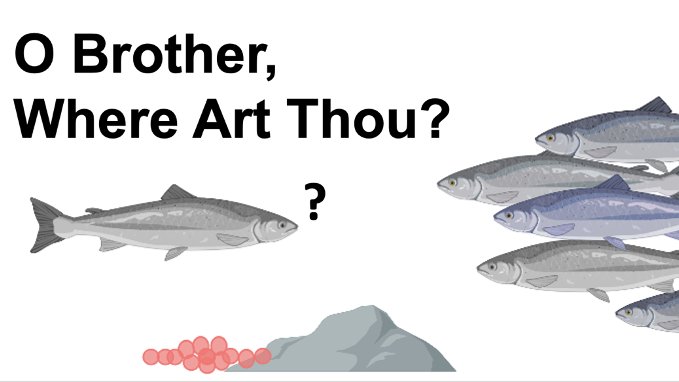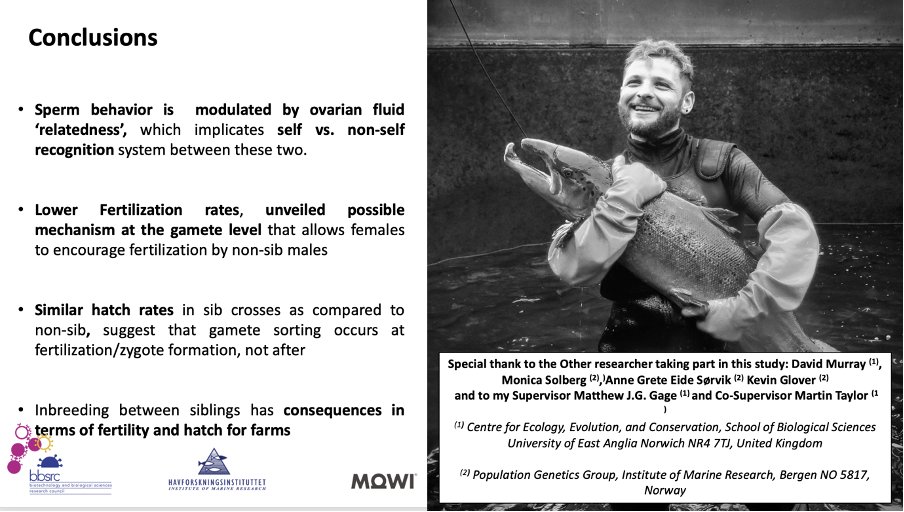1/6 #UEACEEC21 #Sesh1
Salmon usually return to their natal streams to spawn, presenting a risk of breeding between close genetic relatives.
By reducing heterozygosity, #inbreeding can deplete the genetic variability of a population, affecting offspring fitness and survival
Salmon usually return to their natal streams to spawn, presenting a risk of breeding between close genetic relatives.
By reducing heterozygosity, #inbreeding can deplete the genetic variability of a population, affecting offspring fitness and survival

2/6 #UEACEEC21 #Sesh1
However, #salmons are externally fertilisers and females are polyandrous. So how do females control #fertilisation when this occurs outside of their bodies?
Can they somehow hamper fertilisation from their siblings?#evolution may have allowed such mechanisms
However, #salmons are externally fertilisers and females are polyandrous. So how do females control #fertilisation when this occurs outside of their bodies?
Can they somehow hamper fertilisation from their siblings?#evolution may have allowed such mechanisms

3/6 #UEACEEC21 #Sesh1
To test this, we analysed #spermmotility in sibling vs non-sibling ovarian fluid, a substance released with eggs and involved in #sexualselection in #fish. Then, we compared #fertility & hatch rates between sib vs non-sib crosses after #invitro fertilisation
To test this, we analysed #spermmotility in sibling vs non-sibling ovarian fluid, a substance released with eggs and involved in #sexualselection in #fish. Then, we compared #fertility & hatch rates between sib vs non-sib crosses after #invitro fertilisation

4/6 #UEACEEC21 #Sesh1
We found that sperm behaviour, a key factor in fertilisation success, was significantly different in sibling vs non-sibling ovarian fluid, with #spermatozoa activated in sibling fluid showing reduced motility & swimming performance
We found that sperm behaviour, a key factor in fertilisation success, was significantly different in sibling vs non-sibling ovarian fluid, with #spermatozoa activated in sibling fluid showing reduced motility & swimming performance
5/6 #UEACEEC21 #Sesh1
Males also suffered 18%lower fertilisation rates when crossed with sibling females. However, we found no difference in hatch rates among fertilised eggs produced by sib /non-sib crosses, suggesting that gamete sorting occurs at fertilisation/zygote formation
Males also suffered 18%lower fertilisation rates when crossed with sibling females. However, we found no difference in hatch rates among fertilised eggs produced by sib /non-sib crosses, suggesting that gamete sorting occurs at fertilisation/zygote formation

6/6 #UEACEEC21 #Sesh1
Our findings indicate that post-mating inbreeding avoidance mechanisms have evolved at the gamete level in salmon, probably through interaction between ovarian fluid biochemistry and sperm swimming behaviour
#selfnonselfrecognition #gametevolution
Our findings indicate that post-mating inbreeding avoidance mechanisms have evolved at the gamete level in salmon, probably through interaction between ovarian fluid biochemistry and sperm swimming behaviour
#selfnonselfrecognition #gametevolution

• • •
Missing some Tweet in this thread? You can try to
force a refresh




